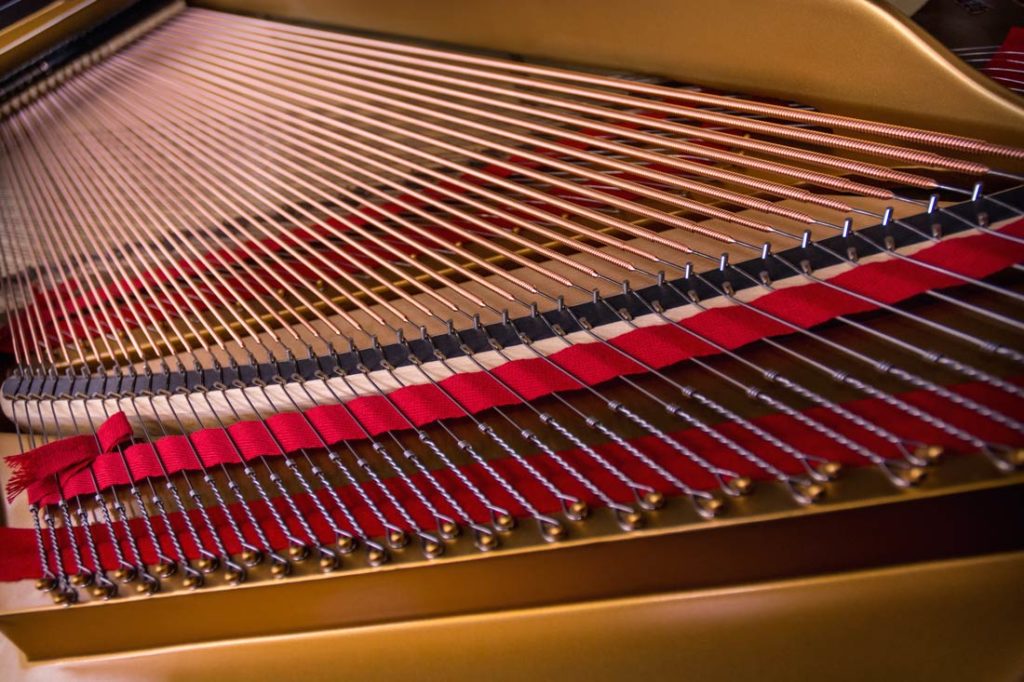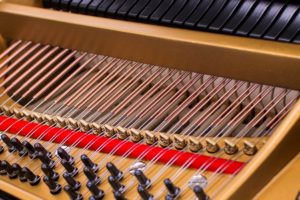Piano Strings | Music in the Wire
Piano strings are one of the most important tone producing parts of any piano. The choice of high-quality music wire is essential for producing a clean and pleasant tone. Steel utilized in piano strings must withstand incredibly high tension, repeated stretching and relentless blows from the piano’s hammers. Precise manufacturing is required for a consistent and clean tonal quality.
Piano wire is made of tempered high carbon steel. This high grade of steel is also sometimes known as ‘spring steel’ due to it being highly tensile and highly elastic. Such strength and elasticity are crucial for strings. Together they will create approx. 38,000 – 40,000 pounds of tension when a piano is tuned to the standard universal pitch of A440. Piano strings are attached to hitch pins near the tail end of the piano and hundreds of tuning pins near the keyboard. The strings are tightly coiled around the tuning pins 3-4 times to ensure they do not slip off when tension is applied to the string. The strings pass over a bridge which transmits the vibrating string’s energy to the soundboard underneath.
Manufacturing Piano Wire
Musical instrument strings are produced by drawing (or pulling) metal rods through dies (funnels) that decrease in diameter until the wanted dimensions are achieved. This manufacturing practice is one that dates back to the 10th century. Music wire originally utilized brass or iron and during the 1800s a switch was made to high-quality steel. Heavy competition within the industry caused the quality and consistency of piano strings to rise dramatically.
Today, piano strings are pulled by machines to give them the consistency necessary for correct tonal quality. The manufacturing process must be precise. Our premium rebuilt pianos utilize the finest strings available on the market today. We prefer Mapes or GC custom copper wound bass strings. Each hammer is then carefully fitted to the string to ensure it is struck at the proper location. Restringing is a process that takes time and care as there are over 200 strings on a standard grand piano. Each string must be properly fit, cut, coiled and tuned to create the beautiful tone that is desired.
The Composition of Piano Strings
The thinner treble and tenor section strings are single steel wires. The thicker bass strings are crafted from steel music wire cores wrapped in a single or double layer of copper alloy wire. The larger diameter of a bass string creates more mass, which produces a lower tone. When wrapping copper wire around the steel core, consistency of tension throughout the winding is very important to create a cleanly wound string.
We utilize the finest copper wound custom manufactured bass strings available in our fully rebuilt pianos. This is to ensure a rich, clear bass tone. Copper wound bass strings lose their brilliance of tone faster than the unwrapped steel strings. This means that bass string replacement is needed more often.
It’s interesting to note that with larger pianos, the additional length of its bass strings provides more mass without as much diameter. Therefore, a larger piano is going to have a clearer, richer tone in its bass section when compared to a similar piano of smaller size. With increased diameter, the string won’t vibrate as freely or as long. With less diameter, the note can sustain longer. A larger piano allows for a much more powerful bass section.
Humidity Control | Preserving Your Piano Strings
 Maintaining the correct humidity level is important for protecting the integrity of your piano’s strings as much as the soundboard or other parts of your instrument. High humidity can cause oxidation (rusting) of the strings.
Maintaining the correct humidity level is important for protecting the integrity of your piano’s strings as much as the soundboard or other parts of your instrument. High humidity can cause oxidation (rusting) of the strings.
These strings will then have to be replaced to avoid a deadened tone. We highly recommend that you have a Piano Life Saver System from Dampp Chaser installed on your instrument to ensure that the humidity is controlled. We have utilized these systems for years here at Chupp’s Piano Service and have found them to be incredibly useful in prolonging the life of your treasured instrument.







